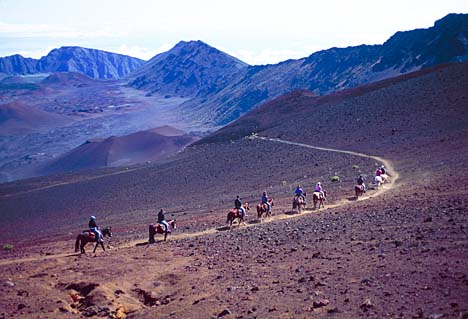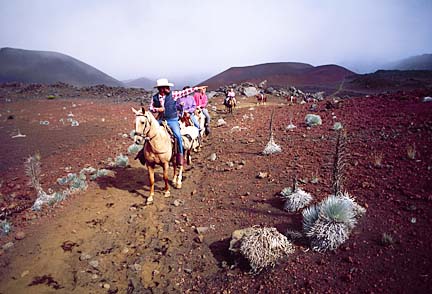

[ SUNDAY TRAVEL ]

On top of the I'M SITTING astride Keala, a pretty bay mare, watching a caravan of clouds float below me. You read that right. Here at the summit of Haleakala Volcano, 10,023 feet above sea level, I'm pretty much on top of the world.
world at Haleakala
Take a horseback tour and look
down upon clouds from
the volcano summitBy Cheryl Chee Tsutsumi
Special to the Star-BulletinFrom the rim of Haleakala, said to be the largest dormant volcano in the world, an amazing panorama unfolds, as unlike the usual images of Hawaii as you can imagine. There are no palm trees here. No silken sands and gardens of tropical flowers. Three thousand feet deep with a circumference of 21 miles,
Haleakala's massive crater is painted a somber slate, ebony and russet. Thousand-foot-high cinder cones punctuate a landscape that, save for occasional sprouts of kupaoa (night cestrum), pukiawe (a native shrub), enaena (cudweed), bracken fern and the otherworldly silversword, is devoid of vegetation.
This day, my group of nine is going to become a part of that awesome landscape as we descend on horseback 2,500 feet to the crater floor, into the heart of Haleakala.
Weather permitting, Pony Express Tours offers the crater ride six days a week. Since he founded the company in January 1982, owner Doug Smith estimates he's done the ride well over 1,000 times and no two experiences have been exactly the same.
Address: P.O. Box 535, Kula, HI 96790 PONY EXPRESS TOURS
Phone: (808) 667-2200
Price: $145 per person, including lunch. A 20 percent discount is offered to local residents. For those who can stand by until the night before the desired ride, a 50 percent discount is offered, based on availability. Reservations are
required. Admission to Haleakala National Park is $10.
Hours: Riders meet in the parking lot of Haleakala Crater Visitors Center at 9:30 a.m. and return at 3 p.m. The ride is offered daily except Sunday.
Restrictions: All riders must be between 10 and 65 years old. Weight limit is 235 pounds. No pregnant women are allowed to ride. The tour is limited to eight riders plus the guide.
Attire: Wear long pants and closed-toe shoes. Bring a hat, jacket and sunscreen. Dress in layers as the temperature usually warms up as you descend from the crater rim.
Web site: http://www.maui.net/~ponex/
"The sides of the circular cinder cones continually catch the sun's rays from different angles as the sun moves to the west," Smith explains.
"This movement results in these cones becoming a more vivid red as the day progresses. The clouds, especially the high, wispy cirrus, which we used to call 'mares tails,' are a great contrast to the beautiful blues of the sky.
"At the 10,000-foot elevation, we're looking down on the other clouds, which are constantly being sculpted by the trade winds. The clouds sometimes throw swiftly moving shadows across the cinder cones. I actually prefer going into the crater on an overcast day because the clouds add such drama to the scene," Smith says.
Haleakala's unpredictable weather also augments the thrill of the ride. When you mount up in the morning, it can be chilly, in the low 50s. By midday, when you're lunching on the crater floor, the temperature may have risen to the high 60s, warm enough for you to peel off your jacket.
All along the four-hour, seven-and-a-half-mile trail, Smith shares fascinating stories about Haleakala and its significance in Hawaiian history. He relates a favorite legend about Maui, the courageous demigod who climbed to the summit of the volcano and lassoed the sun, forcing it to move more slowly across the sky so villagers would have more daylight hours to complete their chores. He points out intriguing plants that have somehow managed to survive in the crater's dry, rocky terrain, among them the rare silversword, which blooms magnificently just once before dying.

"After 19 years of doing crater rides, I still see sights I've never seen before, sights that've made me stop my horse and gape," Smith said. The Specter of the Brocken, a natural phenomenon that enables a person to see his own shadow in a circle of colored mist, is one such sight. According to Smith, "It doesn't happen often. You'll see it maybe once in years because all the conditions have to be just right with the sun, the clouds and the mist."
Smith was inspired to launch Pony Express after his first hike in Haleakala Crater. "I thought, 'If I could only find a way to spend more time in this beautiful place, it would be awesome!' I took out my first paying customers on horses I leased because I couldn't afford to buy my own. My wife, Kathryn, answered the phones when I was riding, and put up with saddles stored in the living room. I was the only guide for about three years. When we first started, we were happy when we had four riders.
"That was our maximum back then; now four is our minimum," Smith says.
There currently are 20 horses in Pony Express' stable, with five more due to arrive this month in anticipation of the summer rush (the company also offers rides on Haleakala Ranch, located at the 4,200-foot elevation of the volcano). Smith has guided all five of Pony Express' tours, but he most enjoys going into the crater.
"The riders range from experienced to novice, heavy to light, young to old, short to tall; you get the point," Smith says. "They're all different, but they have one thing in common; they've all come to see Haleakala and they are rarely disappointed. Their exclamations of wonder at every turn remind me of how I felt when I first saw Haleakala. Add nine exceptional horses to the mix and you've got the greatest job in the world on the greatest island in the Pacific in the greatest place on Maui!"